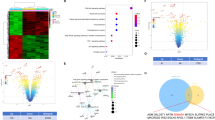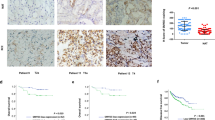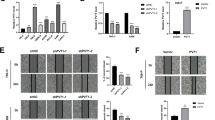Abstract
Inactivation of the von Hippel–Lindau (VHL) tumor suppressor gene underlies the majority of sporadic clear cell renal cell carcinomas (CCRCCs) and is also responsible for the hereditary VHL cancer syndrome. VHL loss of function results in constitutive stabilization of hypoxia-inducible factors (HIF-1α and HIF-2α) due to insufficient proteolysis in the presence of oxygen. This activates multiple genes relevant to tumorigenesis, allowing cells to acquire further mutations and undergo malignant transformation. However, the specific role of each HIF-α subunit in CCRCC tumorigenesis is not yet well understood. The current paradigm supports that in the first stages of CCRCC formation the stabilization of HIF-1α is dominant and this limits proliferation, but later on HIF-2α increases and this induces a more aggressive cell behavior. Understanding how this transition happens is highly relevant, as it may provide novel ways to treat these cancers. Here, we show that VHL inactivation in CCRCC cells results in HIF-1α/2α-dependent downregulation of HIF-1α mRNA through direct binding of either subunit to a reverse hypoxia-response element in the HIF-1α proximal promoter. This binding activates a series of repressive histone modification marks including histone 3 lysine 27 trimethylation (H3K27me3) to make the changes stable, and if overturned reduces CCRCC cell proliferation due to excessive HIF-1α expression level. Our findings thus help understand how HIF-α subunits influence each other and also reinforce the idea that epigenetic mechanisms are a key step of CCRCC progression.
This is a preview of subscription content, access via your institution
Access options
Subscribe to this journal
Receive 50 print issues and online access
$259.00 per year
only $5.18 per issue
Buy this article
- Purchase on Springer Link
- Instant access to full article PDF
Prices may be subject to local taxes which are calculated during checkout




Similar content being viewed by others
References
Aragones J, Jones DR, Martin S, San Juan MA, Alfranca A, Vidal F et al. (2001). Evidence for the involvement of diacylglycerol kinase in the activation of hypoxia-inducible transcription factor 1 by low oxygen tension. J Biol Chem 276: 10548–10555.
Bellot G, Garcia-Medina R, Gounon P, Chiche J, Roux D, Pouyssegur J et al. (2009). Hypoxia-induced autophagy is mediated through hypoxia-inducible factor induction of BNIP3 and BNIP3L via their BH3 domains. Mol Cell Biol 29: 2570–2581.
Beyer S, Kristensen MM, Jensen KS, Johansen JV, Staller P . (2008). The histone demethylases JMJD1A and JMJD2B are transcriptional targets of hypoxia-inducible factor HIF. J Biol Chem 283: 36542–36552.
Christophersen NS, Helin K . (2010). Epigenetic control of embryonic stem cell fate. J Exp Med 207: 2287–2295.
Cory S, Adams JM . (2002). The Bcl2 family: regulators of the cellular life-or-death switch. Nat Rev Cancer 2: 647–656.
Dalgliesh GL, Furge K, Greenman C, Chen L, Bignell G, Butler A et al. (2010). Systematic sequencing of renal carcinoma reveals inactivation of histone modifying genes. Nature 463: 360–363.
Dayan F, Roux D, Brahimi-Horn MC, Pouyssegur J, Mazure NM . (2006). The oxygen sensor factor-inhibiting hypoxia-inducible factor-1 controls expression of distinct genes through the bifunctional transcriptional character of hypoxia-inducible factor-1alpha. Cancer Res 66: 3688–3698.
Esteban MA, Harten SK, Tran MG, Maxwell PH . (2006a). Formation of primary cilia in the renal epithelium is regulated by the von Hippel-Lindau tumor suppressor protein. J Am Soc Nephrol 17: 1801–1806.
Esteban MA, Tran MG, Harten SK, Hill P, Castellanos MC, Chandra A et al. (2006b). Regulation of E-cadherin expression by VHL and hypoxia-inducible factor. Cancer Res 66: 3567–3575.
Gordan JD, Lal P, Dondeti VR, Letrero R, Parekh KN, Oquendo CE et al. (2008). HIF-alpha effects on c-Myc distinguish two subtypes of sporadic VHL-deficient clear cell renal carcinoma. Cancer Cell 14: 435–446.
Guo K, Searfoss G, Krolikowski D, Pagnoni M, Franks C, Clark K et al. (2001). Hypoxia induces the expression of the pro-apoptotic gene BNIP3. Cell Death Differ 8: 367–376.
Hergovich A, Lisztwan J, Barry R, Ballschmieter P, Krek W . (2003). Regulation of microtubule stability by the von Hippel-Lindau tumour suppressor protein pVHL. Nat Cell Biol 5: 64–70.
Jeong CH, Lee HJ, Cha JH, Kim JH, Kim KR, Yoon DK et al. (2007). Hypoxia-inducible factor-1 alpha inhibits self-renewal of mouse embryonic stem cells in vitro via negative regulation of the leukemia inhibitory factor-STAT3 pathway. J Biol Chem 282: 13672–13679.
Kaelin Jr WG . (2002). Molecular basis of the VHL hereditary cancer syndrome. Nat Rev Cancer 2: 673–682.
Kaelin Jr WG . (2008). The von Hippel-Lindau tumour suppressor protein: O2 sensing and cancer. Nat Rev Cancer 8: 865–873.
Koshiji M, Kageyama Y, Pete EA, Horikawa I, Barrett JC, Huang LE . (2004). HIF-1alpha induces cell cycle arrest by functionally counteracting Myc. EMBO J 23: 1949–1956.
Koslowski M, Luxemburger U, Tureci O, Sahin U . (2011). Tumor-associated CpG demethylation augments hypoxia-induced effects by positive autoregulation of HIF-1alpha. Oncogene 30: 876–882.
Kothari S, Cizeau J, McMillan-Ward E, Israels SJ, Bailes M, Ens K et al. (2003). BNIP3 plays a role in hypoxic cell death in human epithelial cells that is inhibited by growth factors EGF and IGF. Oncogene 22: 4734–4744.
Lee KJ, Lee KY, Lee YM . (2010). Downregulation of a tumor suppressor RECK by hypoxia through recruitment of HDAC1 and HIF-1alpha to reverse HRE site in the promoter. Biochim Biophys Acta 1803: 608–616.
Lin Q, Cong X, Yun Z . (2011). Differential hypoxic regulation of hypoxia-inducible factors 1α and 2α. Mol Cancer Res (doi:10.115811541-7786.MCR-11-0053).
Mandriota SJ, Turner KJ, Davies DR, Murray PG, Morgan NV, Sowter HM et al. (2002). HIF activation identifies early lesions in VHL kidneys: evidence for site-specific tumor suppressor function in the nephron. Cancer Cell 1: 459–468.
Maxwell PH, Wiesener MS, Chang GW, Clifford SC, Vaux EC, Cockman ME et al. (1999). The tumour suppressor protein VHL targets hypoxia-inducible factors for oxygen-dependent proteolysis. Nature 399: 271–275.
Mazure NM, Chauvet C, Bois-Joyeux B, Bernard MA, Nacer-Cherif H, Danan JL . (2002). Repression of alpha-fetoprotein gene expression under hypoxic conditions in human hepatoma cells: characterization of a negative hypoxia response element that mediates opposite effects of hypoxia inducible factor-1 and c-Myc. Cancer Res 62: 1158–1165.
Menrad H, Werno C, Schmid T, Copanaki E, Deller T, Dehne N et al. (2010). Roles of hypoxia-inducible factor-1alpha (HIF-1alpha) versus HIF-2alpha in the survival of hepatocellular tumor spheroids. Hepatology 51: 2183–2192.
Morris MR, Ricketts CJ, Gentle D, McRonald F, Carli N, Khalili H et al. (2011). Genome-wide methylation analysis identifies epigenetically inactivated candidate tumour suppressor genes in renal cell carcinoma. Oncogene 30: 1390–1401.
Narravula S, Colgan SP . (2001). Hypoxia-inducible factor 1-mediated inhibition of peroxisome proliferator-activated receptor alpha expression during hypoxia. J Immunol 166: 7543–7548.
Pescador N, Cuevas Y, Naranjo S, Alcaide M, Villar D, Landazuri MO et al. (2005). Identification of a functional hypoxia-responsive element that regulates the expression of the egl nine homologue 3 (egln3/phd3) gene. Biochem J 390: 189–197.
Pollard PJ, Loenarz C, Mole DR, McDonough MA, Gleadle JM, Schofield CJ et al. (2008). Regulation of Jumonji-domain-containing histone demethylases by hypoxia-inducible factor (HIF)-1alpha. Biochem J 416: 387–394.
Pugh CW, Ratcliffe PJ . (2003). Regulation of angiogenesis by hypoxia: role of the HIF system. Nat Med 9: 677–684.
Raval RR, Lau KW, Tran MG, Sowter HM, Mandriota SJ, Li JL et al. (2005). Contrasting properties of hypoxia-inducible factor 1 (HIF-1) and HIF-2 in von Hippel-Lindau-associated renal cell carcinoma. Mol Cell Biol 25: 5675–5686.
Roberts AM, Watson IR, Evans AJ, Foster DA, Irwin MS, Ohh M . (2009). Suppression of hypoxia-inducible factor 2alpha restores p53 activity via Hdm2 and reverses chemoresistance of renal carcinoma cells. Cancer Res 69: 9056–9064.
Schofield CJ, Ratcliffe PJ . (2004). Oxygen sensing by HIF hydroxylases. Nat Rev Mol Cell Biol 5: 343–354.
Schuettengruber B, Chourrout D, Vervoort M, Leblanc B, Cavalli G . (2007). Genome regulation by polycomb and trithorax proteins. Cell 128: 735–745.
Semenza GL . (2001). HIF-1, O(2), and the 3 PHDs: how animal cells signal hypoxia to the nucleus. Cell 107: 1–3.
Semenza GL . (2003). Targeting HIF-1 for cancer therapy. Nat Rev Cancer 3: 721–732.
Varela I, Tarpey P, Raine K, Huang D, Ong CK, Stephens P et al. (2011). Exome sequencing identifies frequent mutation of the SWI/SNF complex gene PBRM1 in renal carcinoma. Nature 469: 539–542.
Wenger RH, Stiehl DP, Camenisch G . (2005). Integration of oxygen signaling at the consensus HRE. Sci STKE 2005: re12.
Xu J, Li H, Wang B, Xu Y, Yang J, Zhang X et al. (2010). VHL inactivation induces HEF1 and Aurora kinase A. J Am Soc Nephrol 21: 2041–2046.
Yoo CB, Jones PA . (2006). Epigenetic therapy of cancer: past, present and future. Nat Rev Drug Discov 5: 37–50.
Acknowledgements
This work was supported by start-up funding from the Guangzhou Institutes of Biomedicine and Health and the Chinese Academy of Sciences Grant KSCX2-YW-R-244 to MAE. We thank Dr Duanqing Pei for his constant support.
Author information
Authors and Affiliations
Corresponding author
Ethics declarations
Competing interests
The authors declare no conflict of interest.
Additional information
Supplementary Information accompanies the paper on the Oncogene website .
Rights and permissions
About this article
Cite this article
Xu, J., Wang, B., Xu, Y. et al. Epigenetic regulation of HIF-1α in renal cancer cells involves HIF-1α/2α binding to a reverse hypoxia-response element. Oncogene 31, 1065–1072 (2012). https://doi.org/10.1038/onc.2011.305
Received:
Revised:
Accepted:
Published:
Issue Date:
DOI: https://doi.org/10.1038/onc.2011.305
Keywords
This article is cited by
-
The role of HIF in angiogenesis, lymphangiogenesis, and tumor microenvironment in urological cancers
Molecular Biology Reports (2024)
-
HCMV-miR-US33-5p promotes apoptosis of aortic vascular smooth muscle cells by targeting EPAS1/SLC3A2 pathway
Cellular & Molecular Biology Letters (2022)
-
Kidney cancer biomarkers and targets for therapeutics: survivin (BIRC5), XIAP, MCL-1, HIF1α, HIF2α, NRF2, MDM2, MDM4, p53, KRAS and AKT in renal cell carcinoma
Journal of Experimental & Clinical Cancer Research (2021)
-
Inhibin A regulates follicular development via hormone secretion and granulosa cell behaviors in laying hens
Cell and Tissue Research (2020)
-
HIF-1α and HIF-2α differently regulate tumour development and inflammation of clear cell renal cell carcinoma in mice
Nature Communications (2020)



